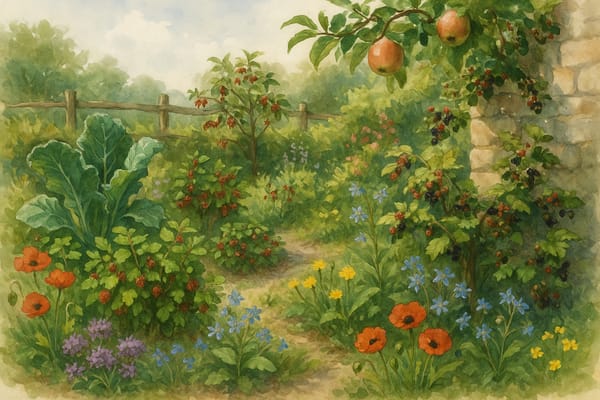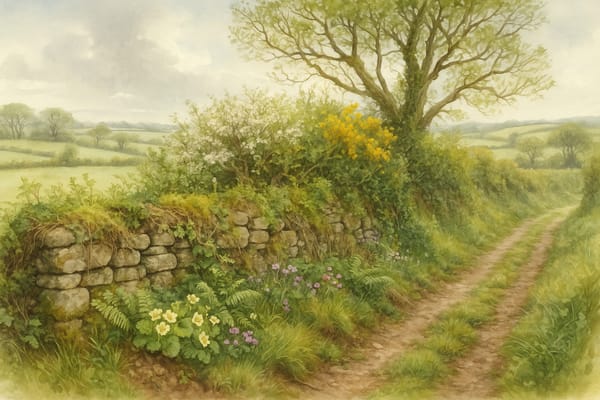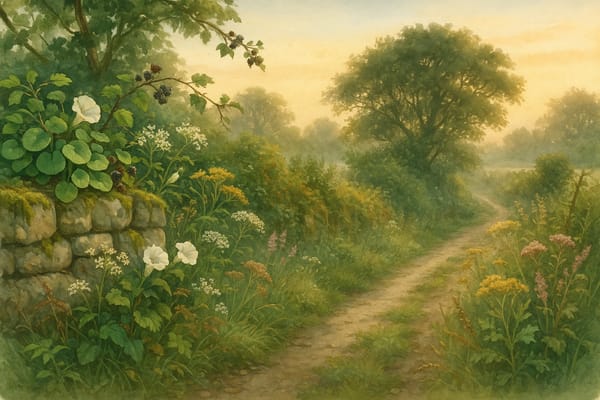In Cornwall, where hedgerows brim with sloes, wild strawberries creep through cottage gardens, and sea kale thrives on coastal banks, it feels only natural to blur the lines between the cultivated and the wild. An Edible Wild Cornish Garden celebrates this gentle fusion—where productive plants, native species, and wildlife coexist in a living landscape that feels both abundant and untamed.
This style of gardening doesn’t follow strict rows or sterile beds. Instead, it embraces layered planting, heritage fruits, edible hedgerows, wild herbs, and the principles of mindful foraging. The result is a garden that feeds the body, nourishes biodiversity, and reconnects you with the ancient rhythms of the land.
Forest Gardens — Nature’s Layered Larder
Inspired by natural woodland systems, Cornish forest gardens are multi-tiered spaces that mimic wild habitats while providing food. Fruit and nut trees like apple, plum, hazel, and crab apple form a dappled canopy. Beneath them, berry shrubs such as currants, gooseberries, and heritage damsons nestle alongside perennial vegetables—wild garlic, sorrel, sea beet, and mint weaving a fragrant, edible groundcover.
These layered spaces aren’t just productive. They provide vital shelter for birds, bees, small mammals, and countless invertebrates. Every plant plays a dual role: feeding both people and nature.
Wild Herbs & Edible “Weeds” — Nature’s Generosity
In a Wild Cornish Garden, so-called “weeds” are often welcomed. Wild marjoram, nettle, chickweed, herb robert, and plantain offer foragers edible leaves, herbal teas, and delicate salad greens. Their presence supports pollinators, boosts soil health, and brings surprising beauty to wild borders.
By allowing these plants to self-seed around your garden’s edges or in quiet corners, you’ll create a dynamic, ever-changing tapestry that supports wildlife and fills your kitchen basket with flavor.
Heritage Fruit — Guardians of Cornish Flavour
Cornwall’s heritage fruit trees are living connections to the past. Varieties like Cornish Gilliflower, Ben’s Red, Pendragon, and Manaccan Primrose offer unique flavors, regional resilience, and a rich cultural history.
Heritage orchards—whether grand or modest—are biodiversity hotspots. Their gnarly trunks and lichened branches shelter countless creatures, while their spring blossom feeds early pollinators. Planting these traditional varieties safeguards Cornwall’s horticultural legacy while adding rare tastes to your table.
Edible Hedgerows — Living Larders for All Seasons
A well-designed edible hedgerow serves as boundary, harvest, and habitat in one. Blackthorn for sloes, hawthorn for haws and blossom, hazel for nuts, elder for flowers and berries, and dog rose for hips create a living corridor that supports birds, pollinators, and people.
Letting hedgerows grow a little wild encourages maximum blossom and fruit production—and offers critical shelter for wildlife. Mixed planting in staggered rows ensures dense growth, diverse forage, and structural beauty throughout the year.
Wild Corners & Foraging — The Art of Shared Abundance
The true magic of an Edible Wild Cornish Garden lies in its invitation to slow down and forage—mindfully. Let patches of bramble, raspberry, wild strawberry, and even medlar find their place in wilder corners. Follow ethical foraging guidelines: take only a share, leave enough for wildlife, and harvest with a deep respect for the land.
Foraging isn’t just about sustenance—it’s about connection. Every handful of blackberries, every sprig of wild mint ties you to the living world around you.
Low-Intervention Crops — Growing with Nature
Focusing on perennials, self-seeders, and hardy heritage varieties reduces the need for digging, fertilisers, and watering. Plants like asparagus, rhubarb, sea kale, perennial kales, Jerusalem artichoke, and sorrel thrive with minimal intervention.
These low-maintenance crops support soil health, promote biodiversity, and align with the natural rhythms of the Cornish landscape—making them perfect companions in a wild edible garden.
Getting Started — Practical Tips for Edible Wild Gardening
- Mix edible natives with fruit trees and berry shrubs.
- Layer planting for yield, habitat, and beauty.
- Let wild herbs and self-seeders naturalise.
- Harvest mindfully, sharing abundance with wildlife.
- Celebrate both the planned and the accidental—let your garden tell its own story.
Why It Matters
An Edible Wild Cornish Garden isn’t just a charming aesthetic. It’s a meaningful way to reconnect with local traditions, contribute to biodiversity, and enjoy food that comes not from rows of plastic-wrapped produce—but from your own flourishing, untamed landscape.
In this garden, beauty, utility, and wildness meet—offering you a slice of Cornwall’s generous heart, right outside your door.











